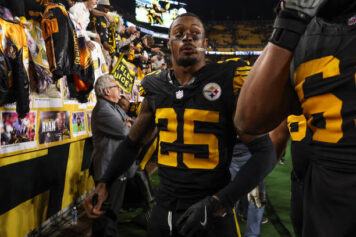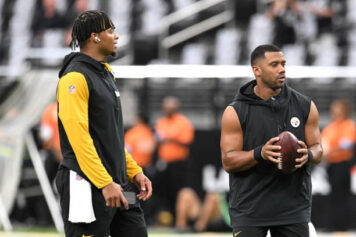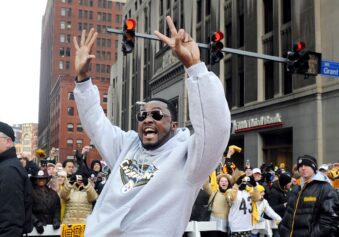Pittsburgh Steelers owner Art Rooney said he had wanted to retire Hall of Famer Mean Joe Greene’s number for years, but the concern always was the number of other jerseys that would have to be retired because Steelers history is flooded with all-time greats, particularly on those ‘70s Dynasty squads boasting 10 Hall of Famers, including HC Chuck Noll.
Rooney said he felt the team’s emotional Spartacus and personality programmer – Charles Edward Greene, also known as “Mean Joe” Greene – deserved to be the first to receive the honor.
And why not?
In addition to being considered one of the most dominating and ferocious defensive lineman to ever pop pads in the NFL, The “Texas Tornado” was the cornerstone of the legendary “Steel Curtain” defense, winning two NFL Defensive Player of the year awards, wreaking Super Bowl havoc and flossing five First-Team All-Pro nods.
Greene played from 1969 until 1981 and was the defensive general and team leader of the Black-n-Gold’s march to four Super Bowl victories in a six-year span from 1975-80. He was elected to the Pro Football Hall of Fame in 1987.
“I don’t think it was a difficult decision at all, because it was Joe Greene,” Dan Rooney said about the Steelers legend who, was voted the rookie of the year and made 10 consecutive trips to the Pro Bowl.
After his playing career, Greene coached for the Steelers from 1987-91 and later served nine years as a Steelers scout.
“It was not a difficult decision as far as we were concerned because of what Joe was. This doesn’t take anything away from Ernie (Holmes). Joe is something special. What he did, the way he acted. He is much deserving of this honor.”
“I think this is a tremendous thing to do. Joe was the cornerstone to the team. Chuck Noll came and the first pick he made was Joe. Joe had a great determination to win. He pushed everyone in the organization.”
MJG’s No. 75 will officially be retired Nov. 2 when the Steelers play host to the Baltimore Ravens at Heinz Field, the Rooneys announced Wednesday.
“I feel so wonderful,” Greene said. “I was flabbergasted when Dan and Art mentioned it to me. I know what it means to the Steelers when they do something of this magnitude. I say that because they haven’t done it in a long time.”
For 50 years, Ernie Stautner, a fellow defensive tackle, had been the only Steelers player to have his jersey number (70) retired. That was done at Pitt Stadium in 1964.
With the passing of L.C. Greenwood in 2013, Greene is the last surviving member of that vaunted front four (Greene, Ernie Holmes, Greenwood and Dwight White), which probably also factored into the Rooney Family choosing to anoint the 67-year-old legendary defensive tackle.
Indeed, that '70s Steelers squad – rampant steroid use or not – had Hall of Fame talent at almost every position, especially the glamour positions of QB (Terry Bradshaw), running back (Franco Harris) and wide receiver (John Stallworth, Lynn Swann). With that in mind, there’s obviously something more enthralling about Mean Joe Greene besides his stellar, raging, ball-carrier-bashing tactics on the field. For a defensive tackle to become the most notable and popular face on a football squad, he has to not only stand out like the 6-4, 275-pound Greene did, but have a personality that can captivate an entire legion of football fans.
MJG had that. He played football with the flair of an offensive player, but maintained his defensive stench, making no bones about his lethally disrespectful attitude toward trench warfare and opposing quarterbacks.
He was almost uncontrollable at times. Greene and his Steel Curtain familia represented the essence of oldschool, smash-mouth football, before the flood of rules that has transformed the game into rough-touch flag football. He stepped on groins, fought with opposing lineman and exemplified the dungeon-deep bond and grit and relentless consistency that all-time defenses possess. Long before entire franchises were brought to their knees for paying defenders extra incentive bonuses to put opposing players to sleep, MJG and The Steel Curtain regularly did that for free. It was their job.
Mean Joe Greene Goes Hollywood
Greene was also one of the first players to capitalize on the rising impact of sports television, marketing and promotions, especially during The Super Bowl. With the thousands of classic commercials that have aired during numerous NFL Super Bowls, perhaps the most memorable one to this day is Greene’s "Hey Kid, Catch!" Coca-Cola commercial in 1979, which won a Clio Award in 1980 and is widely considered to be one of the best television commercials ever made.
The commercial was authentic and believable and it propelled Greene to a celebrity status beyond football. A large part of the commercial’s popularity lied in the fact that it represented the beauty of American athletics and the classic moments in sports that transcend race and contribute positively to progressive thought.
Here you had an African-American male who beats the snot out of guys for a living, but was a role model and an idol for a young white child. It was the classic example of sports breaking barriers and it’s one of those lasting creations of marketing genius which helped usher in the 80s.
The commercial debuted on Oct. 1, 1979 and then was aired again during the Super Bowl, which was broadcast to record numbers of people and has traditionally been a ratings bonanza.
When Greene hobbled into the tunnel leading to the locker room looking like a defeated, aging warrior, he automatically captured the sympathies of everyone watching.
When the little boy refused to fall back until Greene took his Coke – that moment captivated every fan who was ever young and dreamed of meeting their hero face to face.
When the kid told Mean Joe that he “was the best ever,” and Joe took the Coke and eventually smiled, it was symbolic of how important fans are to the players and the spirit of the NFL. It showed the tender side of a gladiator. How vulnerable they are once they remove the helmet and ascend into that dark tunnel leading to the trainer’s table and a week of recovery.
How ironic that vicious head-decapitator Mean Joe Greene somehow became the most lovable and famous athlete in the NFL because of a commercial in which one kind gesture of throwing his sweat-ridden jersey to a young fan who cared, had a lasting imprint on the minds of sports fans.
The commercial also propelled Mean Joe’s “acting career” as he’s appeared in a bunch of movies and TV shows including The Black Six (1974), Horror High (1974), Lady Cocoa (1975), Fighting Back: The Rocky Bleier Story (1980TV), Smokey and the Bandit II (1980), The Steeler and the Pittsburgh Kid (1981TV), and most recently a Family Guy episode "Road To Germany" as himself.
The way he's helped brand and enhance the Steelers name is already enough to warrant his jersey retirement ceremony.
However, the dopeness of being the H.N.I.C. of a mythical 47-man team whose feats are yet to be duplicated, moves him to the head of the class for what eventually will be a long-line of retired Pittsburgh Steelers jerseys. For a guy that was all about team and going hard as one unit, it will be nice for Mean Joe Greene to get some solo shine, all these years later.



